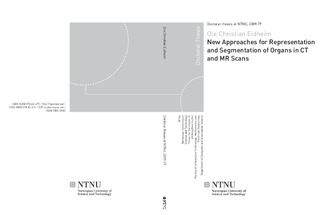New Approaches for Representation and Segmentation of Organs in CT and MR Scans
Doctoral thesis
Permanent lenke
http://hdl.handle.net/11250/252242Utgivelsesdato
2009Metadata
Vis full innførselSamlinger
Sammendrag
Analysis of medical images is resource demanding and time-consuming, and automatic procedures are needed to reduce the workload of medical staff in a pre-operative planning phase. In this thesis, the main focus has been on methods that automatically segment CT and MR volume data, in particular new approaches for representation and segmentation of the liver, hepatic vessels and the kidney.
The two main contributions in this thesis are a new 3D skeleton procedure and a texture-based segmentation method. The skeleton procedure is iterative, without user-defined parameters, and produces a minimalistic representation of binary objects without known artifacts. Compared to previous work, this skeleton method produces more reliable results and does not need tuning for each individual representation task.
The new texture-based segmentation algorithm is used to segment the selected organs, where only a few parameters influence the end result. Moreover, the parameters of this method are relatively easy to set, and a wide parameter range yields acceptable results. This method is more robust than popular previously published procedures that are typically based on edge information.
Additionally, there are two minor contributions in this thesis. A new general representation of binary objects with an interior is presented. This representation is used to automatically derive the parameters of the texturebased segmentation method based on a statistical template. Furthermore, parallel processing on modern graphics cards and multiple CPU processors have been studied and compared to serial algorithms. A significant decrease in runtime was shown on many common image processing techniques in addition to the proposed texture-based segmentation algorithm.
Even though the results are promising, more research is needed before reliable analysis of medical volume data can be performed. In particular, a combination of the proposed techniques incorporated with shape-based and statistical models is suggested for future research. The contributions in this thesis, however, are noticeable and represent a step forward in deriving complete automatic procedures for segmentation of medical volume data.
